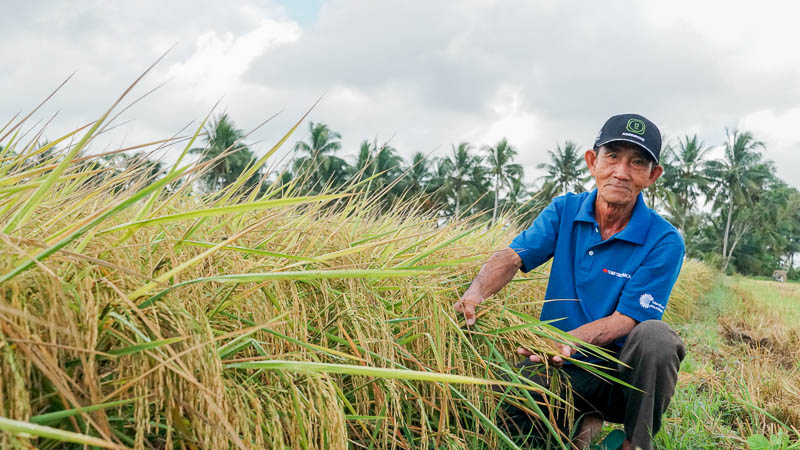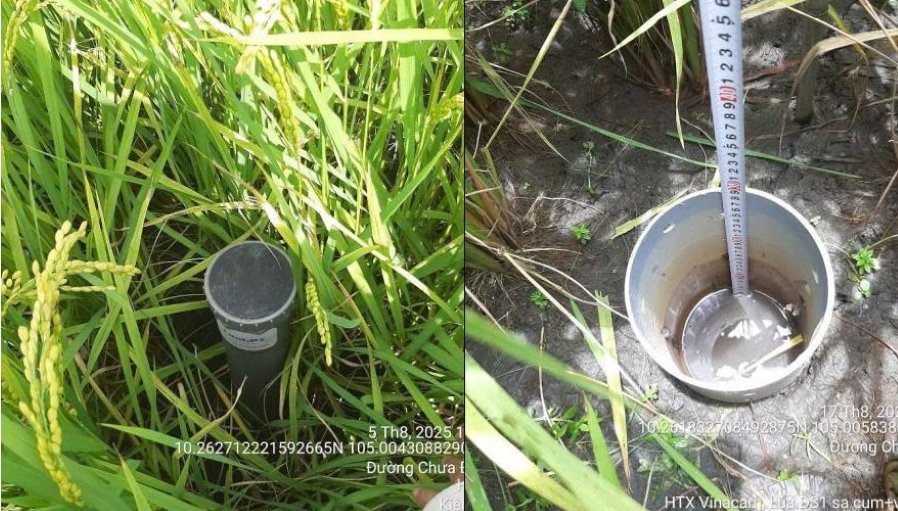At Nghia Thang Agricultural Cooperative (My Xuyen Ward, Can Tho City), the rice farming model using the intercropping dry flooding technique (AWD) has brought clear economic, environmental and crop growth efficiency.
Mr. Hua Thanh Nghia, Director of the Cooperative, said that in the recent Summer-Autumn crop, the Cooperative had 50 hectares of rice participated in the Project of 1 million hectares of high-quality, low-emission rice associated with green growth in the Mekong Delta until 2030. During the farming process, members apply a synchronous water management process according to the AWD method. Thanks to proper water regulation, rice plants are "trained" in alternating moisture-dried conditions, helping the roots to eat deeply, have a hard trunk, reduce falls and limit pests and diseases.
According to Mr. Nghia, the process starts with treating straw after harvest: the fields are drained with floodwater and then removed to drain toxic gases. When planting, only keep a moderate amount of moisture. At 7, 24 and 38 days of age, water is provided by cycle; after 40 - 45 days, the water is drained to destroy inactively the potholes and help the roots eat more. The blossoming phase will keep water at a reasonable level, continue to let it dry alternately for good respiratory roots. 10 - 14 days before harvest, steep the water to dry the fields, helping to improve the quality of the seeds and facilitate machine harvesting.
Thanks to applying the above process, production costs are significantly reduced, rice is healthy and there are few pests. The yield is 6 - 7 tons/ha, some places reach 7.5 tons/ha. Although the recent rice price was VND9,000/kg, lower than the same period, farmers still had a profit of VND4,000 - 5,000/kg. The rice is of high quality, has bright, sturdy seeds and is stablely guaranteed by enterprises, helping farmers feel secure in production.

Through practical application, Mr. Tran Van Chin, a farmer in Dai Ngai commune (Can Tho city), said that the alternate dry irrigation method helps the fields always maintain soil moisture, thanks to which when there is a risk of salinity intrusion, farmers still have time to proactively regulate and supplement water, without having to keep the water level as high as before.
"Previously, people often kept water flooded continuously, not draining water throughout the crop. When applying the AWD technique correctly, the water will be drained - supplied according to the cycle of 2-3 times. Thanks to that, farmers no longer depend on water sources much," Mr. Chin shared.

In An Giang, Mr. Le Van Dung, Deputy Director of the Provincial Agricultural Extension Center, said that in the summer-autumn 2025 crop, the rice-growing model to reduce emissions will be deployed on 50 hectares at Thanh Xuan Agricultural Service Cooperative. As a result, costs decreased by more than 3.26 million VND/ha, economic efficiency increased by 9.45 million VND/ha; profit margin reached 130.3%, up 44.9% compared to outside the model. Regulating water according to each growth stage helps rice roots grow deep, trees are hard and have few pests.
Mr. Dung cited that according to calculations based on the guidance of the Intergovernmental Committee on Climate Change (IPCC, 2019), greenhouse gas emissions have decreased by an average of 11.887 tons of CO2 equivalent per hectare; the reduction of emissions from water management according to Gold Standard standards alone reached 6.68 tons of CO2 equivalent per hectare.

According to the National Agricultural Extension Center, after 2 years of implementing the Project to build a model of rice cultivation to reduce emissions to serve the sustainable development of the rice export region of the Mekong Delta, the model has proven its effectiveness.
The project is implemented on over 600 hectares with 250 households in 5 provinces, with an average yield of 7.49 tons/ha, an increase of 0.33 tons/ha compared to mass production; costs decreased by 3.6 million VND/ha (15.4%); profits increased by 6.21 million VND/ha. Proper water regulation helps reduce emissions, some models recorded a reduction of nearly 12 tons of CO2/ha.











